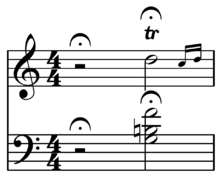Fermata



A fermata (Italian: [ferˈmaːta]; "from fermare, to stay, or stop";[2] also known as a hold, pause, colloquially a birdseye or cyclops eye, or as a grand pause when placed on a note or a rest) is a symbol of musical notation indicating that the note should be prolonged beyond the normal duration its note value would indicate.[3] Exactly how much longer it is held is up to the discretion of the performer or conductor, but twice as long is common. It is usually printed above but can be occasionally below (when it is upside down) the note to be extended.
When a fermata is placed over a bar or double-bar, it is used to indicate the end of a phrase or section of a work. In a concerto, it indicates the point at which the soloist is to play a cadenza.[4]
A fermata can occur at the end of a piece (or movement) or in the middle of a piece. It can be followed by either a brief rest or more notes.[5]
Fermata is the Italian name for the sign (
